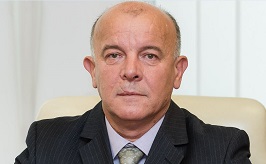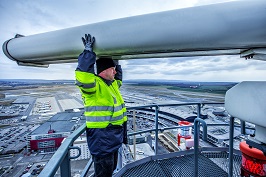FAB CE News
FAB Central Europe (FAB CE) has reappointed Helios and Integra to run its Programme Support Office (PSO) for the next three years.
The PSO is a vital enabler to FAB CE’s work, helping to align it to Single European Sky and SESAR requirements, coordinate actions and track progress across priority programmes spanning business planning, technical harmonisation, common procurement and operations.
In the first two years of support, the FAB CE programme was reviewed and updated in accordance with the latest requirements of the SESAR Deployment Programme (DP). FAB CE, supported by the PSO, has successfully completed the “Free Route Airspace from the Black Forest to the Black Sea” Study, funded by the European Commission’s Innovation and Networks Executive Agency (INEA) and was also successful in achieving INEA funding for its multi-applicant proposals in the competitive 2016 CEF Transport call, aimed at closing further gaps in SESAR DP implementation. FAB CE also completed its first smart/common procurement to upgrade its cross-border telecommunications network (X-bone) hardware and is currently looking at optimisation of the surveillance infrastructure.
FAB CE Programme Manager Matej Eljon said: “The challenge for FAB CE over the next period will be to exploit the cooperative structures already in place and expand our cooperation further to fulfil requirements for new services foreseen by the SESAR Deployment Programme in the most cost-efficient way. We are looking forward to the ongoing support of Helios and Integra, and are confident of meeting the performance targets specified in the FAB CE Performance Plan.”
 The Supervisory Board of Croatia Control Ltd on 29 September 2017 appointed Mr Vlado Bagarić as the new Director General of Croatia Control.
The Supervisory Board of Croatia Control Ltd on 29 September 2017 appointed Mr Vlado Bagarić as the new Director General of Croatia Control.
Vlado Bagarić is a former Commander of the Croatian Air Force and Air Defence. He previously held the position of Assistant Director for ATM/ANS at the Croatian Civil Aviation Agency.
 ATSEP (Air Traffic Safety Electronics Personnel) training managers from FAB Central Europe and FAB Europe Central together with their colleagues from NATS have developed a new common pool of assessment questions to standardise the assessment process for ATSEP training. The objective of this InterFAB initiative is to fill the gap between the requirements defined in the EU Regulation 2017/373 that describes the minimum requirements, but does not define in which way air navigation service providers have to train their staff. To standardise this process, training experts have defined a question pool for the ATSEP basic training containing more than 600 validated questions to be used by the partners The first ATSEP basic assessments have been conducted; this demonstrated the high quality of the questions with respect to comprehensibility, clearness, depth and relation to training objectives.
ATSEP (Air Traffic Safety Electronics Personnel) training managers from FAB Central Europe and FAB Europe Central together with their colleagues from NATS have developed a new common pool of assessment questions to standardise the assessment process for ATSEP training. The objective of this InterFAB initiative is to fill the gap between the requirements defined in the EU Regulation 2017/373 that describes the minimum requirements, but does not define in which way air navigation service providers have to train their staff. To standardise this process, training experts have defined a question pool for the ATSEP basic training containing more than 600 validated questions to be used by the partners The first ATSEP basic assessments have been conducted; this demonstrated the high quality of the questions with respect to comprehensibility, clearness, depth and relation to training objectives.
The QUASAR (QUestionnaire for ATSEP Standard Assessment Routines) initiative, working as the QUASAR Task Force (QTF) is behind the initial idea launched by FABCE partners ANS Czech Republic, Austro Control, BHANSA, CANI, Croatia Control, Hungarocontrol, LPS Slovakia and Slovenia Control. FABEC is represented by DFS, ENAC and Skyguide. In addition, NATS joined in 2015. Based on this first successful step, the QUASAR Task Force started the process of generating question pools for the 17 qualification streams as defined in the EU regulation. The question set for the first stream “Qualification Shared” is expected to be finalised by the end of 2017. Beside this, QUASAR members offer a web based platform to conduct on-line assessments.
The current status of the QUASAR initiative will be presented to a broader audience at the FABEC Training Conference which will take place in Amsterdam on 26/27 September 2017.
 The FAB CE Cyber Security Experts, comprising FABCE information technology (IT) security managers (ITSO) and chief information security officers (CISO) from the seven FAB CE air navigation service providers (ANSPs), met in Vienna on 29 June for the first time, to exchange views on cyber security challenges and examine potential areas of cooperation.
The FAB CE Cyber Security Experts, comprising FABCE information technology (IT) security managers (ITSO) and chief information security officers (CISO) from the seven FAB CE air navigation service providers (ANSPs), met in Vienna on 29 June for the first time, to exchange views on cyber security challenges and examine potential areas of cooperation.
ANSPs face a number of major cyber security challenges apart from the most obvious one of protecting company and operational networks from cyber-attacks. In Europe there are a wide number of working groups set up to pioneer work in this area – including programmes under way within Eurocontrol, the Civil Air Navigation Services Organisation (CANSO) and the European Aviation Safety Agency (EASA) – and one of the roles of the FAB CE Cyber Security Experts is to ensure there is no duplication or effort and to agree on areas of cooperation with the different initiatives under way.
“One of most important challenges is to ensure we have the same open exchange of security information as we have on the safety side,” said Harald Stainoch, Deputy Corporate Security Officer (CSO) at Austro Control and project manager of the organisation’s information security enhancement project. “I think we are one or two or three steps behind in this regard. We all have security challenges but, for understandable reasons, there is a reluctance to share them. The problems are well known but the range of work in IT security is a huge one and I suspect we are at different stages of development.”
While work has begun as part of a Eurocontrol programme to harmonise security protocols around message transmission within the FAB, all European ANSPs face similar challenges in understanding the best way to harmonise programmes and understand the appropriate level of resources required to meet the challenges.
“For the time being the meeting of the FAB CE Security Experts will be focused on the exchange of information - presenting the state of play within each ANSP and perhaps outlining roadmaps for further development,” said Harald Stainoch. “We will, most importantly, be looking at the best ways we can help each other and freely share our best practices in FAB CE.”
 The FAB CE legal entity, FCE Aviation Services, signed its first equipment contract on behalf of six FAB CE member states on 26 June 2017.
The FAB CE legal entity, FCE Aviation Services, signed its first equipment contract on behalf of six FAB CE member states on 26 June 2017.
S&T Slovenija was selected following a competitive tender, issued in May, to deliver common regional telecommunications infrastructure to six air navigation services providers (ANSPs) to support seamless exchange of data between FAB CE member states. Under the single contract, the company is supplying common CISCO routers, in addition to support services for each user, directly to each country in the weeks ahead. The new routers replace an existing equipment network – due renewal – which is used to ensure seamless exchange of a range of messages including surveillance data, aeronautical messages, and to support On-Line Data interchange (OLDI) between FAB CE member states.
FCE Director Matej Eljon said: “We have completed our first infrastructure joint procurement with very good results. We’ve proved we can deliver common smart procurement at a price that meets our expectations.” The activity not only saved money compared to individual procurement country by country, but also secured a lower than estimated common price. The process is now available for use to carry out other smart procurement projects in the future.
To reach this point, FCE had to develop a process in-house that could be used to prepare common technical requirements. In addition, it established a way for ANSPs to be part of the approval process, and to execute the procurement. The work was completed over several months, and concluded with recommendation of the winning bid by the Procurement Assessment Committee. “The process was not there before so we had to invent the process internally,” said Matej. “Now we have proved that it works we are ready to execute procurement with much shorter lead times.”
Smart procurement is a key enabler for the harmonisation and optimisation of FAB CE operations, one of three high level initiatives set out in the FAB CE Strategy, along with safety and performance monitoring, and stakeholder communications. These activities are detailed in 15 FAB CE Strategy objectives which provide the framework for all FAB CE projects. The tasks and projects are updated regularly to ensure they are aligned with the Pilot Common Project, and reflect the goals of the broader European ATM Master Plan.
 The FABCE management team has produced a consolidated response to the Study on Functional Airspace Blocks (FABs), compiled for the European Commission (DG MOVE) earlier this year.
The FABCE management team has produced a consolidated response to the Study on Functional Airspace Blocks (FABs), compiled for the European Commission (DG MOVE) earlier this year.
The study concluded that “FABs have not met the high level policy objectives set by the Single European Sky legislation, despite the substantial efforts undertaken for their implementation” and proposed a series of recommendations to improve FAB performance.
“We think the recommendations for further development could represent a positive step towards clarifying the Commission’s position on FABs,” said Matej Eljon, director of FAB CE Aviation Ltd. “But we also believe that some of the specific recommendations related to FAB CE are already resolved or in the process of being resolved and that the general recommendations should be clearer, more focused and should remove the significant overlap between one other. We believe that progress has been made by FABs.”
The Study identified a number of perceived blockages which were slowing the development of FABs as envisaged in the Single European Sky II package of 2009. These included the adoption by FABs of the consensus principle, which has slowed the speed of decision-making; a lack of political will among States, which has meant air navigation service providers (ANSPs) have prioritized industrial partnerships over FABs; and a lack of sufficient consultation with customers, especially airlines.
“The proposal to allow decision making on a majority basis was considered at length in the development of the governance arrangements,” said Matej Eljon. “But we concluded that such an arrangement would be impossible in a regime in which individual enterprises are responsible for their own risk and liability of ANS services. However, specific decision making mechanisms might be needed to enable some activities only beneficial to a subset of FAB members, to prevent blocking the pursuit of these by other partners.
“FAB CE States have invested a lot in FABs and there is very real political will for FABs,” said Matej Eljon. “For obvious and very practical reasons States cannot be involved in all operational and technical matters of FAB decision making, and it should be seen as a positive and complimentary outcome that Industrial partnerships have emerged.“
Finally, in its letter of response to the Commission, the FABCE management team pointed out that while it supported strong airspace user involvement this relied on having the appropriate resources, background and understanding to develop and implement solutions. Some airspace users, in FAB CE’s experience, have lacked an understanding or willingness to find solutions to ANS challenges - for example, in the slow uptake of VDL2 and ADS-B equipage.
The letter of response asked for the Commission to provide a clear EU level articulation as to the policy objectives, priorities and expectations which should explain how the various elements of SES policy are envisaged to fit together - such as the performance scheme, FABs, competition and industrial partnerships.
Page 24 of 41
